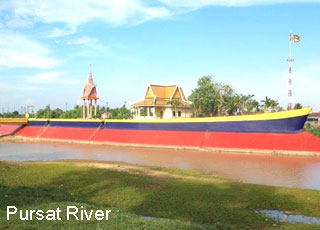 |
| Add caption |
Pursat is the fourth biggest province of Cambodia. The province is located in the western part of the country and borders clockwise from the north with Battambang, the Tonle Sap Lake, Kompong Chhnang, Kompong Speu, Koh Kong, and Thailand.Pursat offers a perfect access to both the Tonle Sap (just 35km far) and the Cardamom Mountains (right to the West). The name of Pursat refers to a type of tree.For the time being, Pursat receives few travellers and the two main attractions,
the Cardamoms and the Tonle Sap require a little initiative on the tourist's part to visit. Pursat is predominantly accessible by the National Highway No 5 form Phnom Penh (174km) and Battambang (106km). There is also an old slowly train working between Phnom Penh and Battambang, which stops outside (2km) from Pursat.
The provincial capital of Pursat is also called Pursat town. The city is located right in the middle between the Tonle Sap and the Cardamom Mountains on the riverbanks of the Stung Pursat. There isn?t that much to do in that small town, so most of the tourists coming here are more or less on their way to Battambang or Phnom Penh. For people just driving by, the impression of a boring ordinary town remains. The only tourist attraction in town is the marble workshops near the bridge on the main street. The precious marble stones originate from the Cardamoms, than they are brought here, followed up and sold near the Lam Siv Eng Restaurant. About 5 km from town is the tomb of Khleang Meung.
The Tonle Sap
Pursat province offers the magnificent opportunity to see one of the larger and markedly less touristy floating villages without a significant investment in time or money. In fact, there are a number of floating villages in the province only accessible from the lake, Peach Kantil, Kbal Taol, and Prek Kr, but you can only see Kompong Luong for the cost of the day-rate for a moto ($6-8) and the cost for a boat ride once you get there.
Central Cardamoms
Pursat offers a relatively easy way to enter this fantastic ecological wonder, the massive Cardamom Mountains. Accessing the central Cardamoms from Pursat is not too difficult as there is a road from Pursat to Veal Veng, a small village between the Mt. Samkos and Mt. Aural Wildlife Sanctuaries. There's really nothing to do but to take a drive through the country, to have a look at the mountains, and to talk to people who don't see many foreigners ? and that is even worth it. There's no organized transport from Pursat to this place, but if you ask around
Pursat Province (Khmer: ខេតុពោសាត់) is the fourth largest province in Cambodia. It is located in the western part of the country and borders clockwise from the north with Battambang Province, the Tonlé Sap, Kampong Chhnang Province, Kampong Speu Province, Koh Kong Province, and Thailand. It is located between the Tonle Sap and the northern end of the Cardamom Mountains. The Pursat river bisects the province, running from the Cardamoms in the west to the Tonle Sap in the east. Pursat is accessible by National Highway 5, by boat, rail and by numerous smaller roads. The capital, Pursat town, lies 174 kilometres north west of Phnom Penh by road and 106 kilometres south east of Battambang.[2]
The province is subdivided into 6 districts.
- 1501 Bakan - បាកាន
- 1502 Kandieng - កណ្ដៀង
- 1503 Krakor - ក្រគរ
- 1504 Phnum Kravanh - ភ្នុំក្រវាញ
- 1505 Sampov Meas - សំពៅមាស
- 1506 Veal Veaeng - វាលវែង
Tour region of Pursat Province
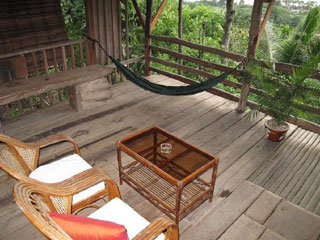 |
| Add caption |
The Bak Tra Resort, Pursat is a very popular destination in the area and it should not be missed. The beauty of the place will surely amaze you like none else. You can reach the Bak Tra Resort, Pursat with ease as there are numerous means of transport available and you can avail hem to reach this spot.
The Bak Tra Resort, Pursat is a natural resort that is worth paying a visit to. You need to travel for about 16 kilometers if you are staying at the provincial capital of Pursat. You need to take the Road Number 56 to reach the Kra Vanh District.
The Bak Tra Resort, Pursat is indeed very beautiful with a small mountain that is about 50 meters in height. There is a forest area as well that has a rich foliage of Thlong trees. There is also a canal and a perennial well in the area. All of these adds to the charm of the place and you should not miss it.
The Bak Tra Resort, Pursat is a natural resort that is worth paying a visit to. You need to travel for about 16 kilometers if you are staying at the provincial capital of Pursat. You need to take the Road Number 56 to reach the Kra Vanh District.
The Bak Tra Resort, Pursat is indeed very beautiful with a small mountain that is about 50 meters in height. There is a forest area as well that has a rich foliage of Thlong trees. There is also a canal and a perennial well in the area. All of these adds to the charm of the place and you should not miss it.
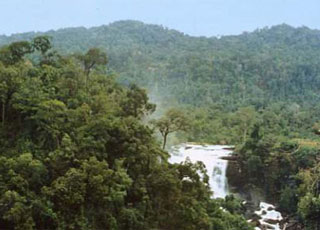 |
| Add caption |
Check the Koh Kong chapter for
information on the fried from Koh Kong to Pailin, which cuts through the Cardamom Mountains on the western edge of Pursat province. The Cardamom Mountains of Koh Kong and Pursat provinces are said to be the most pristine wilderness area remaining in Southeast Asia. This ride takes you through the area.The Cardamom Mountains are located in southwest Cambodia. The western edge of the Cardamom region abuts the Thai border, while the easternmost part ends about sixty miles northwest of the Cambodian capital of Phnom Penh. The region's area is 2.5 million acres (1 million hectares). The highest point in the range (and in Cambodia) is Mount Aural, at 1,813 meters (5,946 feet). There are five main rivers that run through the Cardamoms, creating dozens of waterfalls. About 25,000 people live in this region, some of whom are ethnic minorities, such as the Porr.
There are two wildlife sanctuaries in the Cardamoms, both of which were decreed by King Norodom Sihanouk in 1993 solely on the basis of aerial photographs. Mt. Samkos Wildlife Sanctuary is in the western part of the range, and Mt. Aural Wildlife Sanctuary is in the east. These are "paper"parks only: they exist only by law, with none of the active management necessary for a wildlife preserve.Khmer Rouge guerrillas retreated to the Cardamoms after losing power in 1979, and for the next twenty years, no one wanted to enter that area for fear of the KR and the mines they placed in it. As a result, the region remained untouched and undeveloped. Thousands of Cambodians left the country before and during the KR holocaust by walking over the Cardamoms into refugee camps in Thailand.Today, the Cardamom Mountains region is the largest wilderness in mainland Southeast Asia, preserving a remarkable number of species that are endangered (and in some cases extinct) elsewhere in the world. However, without proper conservation and protection, this area and its inhabitants are now at the mercy of logging interests, as well as poachers.
Densely covered with lush virgin rainforest and rising to it's highest point at over 1,770m, the Cardamoms extend over an area of 4,420,000 hectares (10,922,060 acres) covering a large portion of SouthWestern Cambodia. The Cardamoms are considered to represent Southeast Asia's greatest natural resources in terms of virgin forest and wildlife habitats that have never been fully explored and/or catalogued. In 2000, Fauna and Flora International, Conservation International, and the Cambodian Ministry of Environment and Wildlife Protection Programme conducted a joint survey that covered only a small part of the vast expanse of unexplored land. Despite the minimal area under observation the survey identified 30 large mammal species, 30 small mammal species, more than 450 birds, 64 reptiles, 30 amphibians, and many other plants and insects. To name just a few of the animals indigenous to this area would include elephants, tigers, clouded leopards and a variety of other mammals such as the Malaysian sun bear, pleated gibbons, and Siamese crocodiles all of which are high on the endangered species list and the only significant population thought to exist anywhere.
Fauna & Flora International was the first to conduct extensive field surveys in the Cardamom Mountains of south-west Cambodia. These established the area as one of the last forest wilderness areas in mainland south-east Asia. Isolated by their remoteness and rugged terrain and forgotten during years of conflict in Cambodia, the Cardamoms have at their core a virtually undisturbed forest covering over 10,000 square kilometres. The Cardamom Mountain Wildlife Sanctuaries Project, a joint venture of Fauna & Flora International and Cambodia's Ministry of Environment, aims to ensure the long-term conservation of a landscape of global importance and its biodiversity while reducing poverty and ensuring essential national development. The focus is to establish and maintain management systems in two protected areas in south-west Cambodia: Phnom Samkos Wildlife Sanctuary and Phnom Aural Wildlife Sanctuary.The Cardamom Mountains are now known to contain almost all the country's known mammals, birds, reptiles and amphibians. This is partly due to the very high diversity of habitats, some of which occur nowhere else in Cambodia, such as large expanses of fire-regulated ferns, upper montane forest, high elevation marshes and blackwater rivers.
Floating Village of Lake Tonle Sap
Floating Village of Lake Tonle Sap is heading east from Pursat town, about one-third of the way to Kampong Chhnang town is the town of Krakor. Just a few kilometers to the north are Lake Tonle Sap and the floating village of Kampong Loo-uhng. It?s a complete village on the water populated mostly by Vietnamese fishermen. You can arrange for a small non-motorized boat to show you.
Floating Village of Lake Tonle Sap
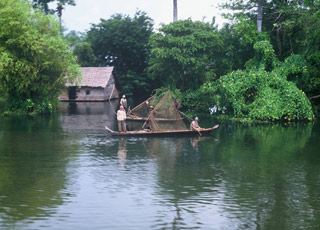 |
| Add caption |
Kam Pong Luong Resort
Kampong Luong is a natural site located on the Tonle Sap in Kampong Luong commune, Krakor district, about 35 kilometers east of Pursat provincial town. The site is a sand cape suitable for swimming during the dry season. During the rainy season, especially during Pchumben, many cambodians gather there to play Chaol Teuk Leak (a traditional Khmer game, played by throwing water on one another) on the river. The game can be dangerous, however, because it is often played while in small boats.
There are four other sites that Pursat residents prefer to visit. They include: -Kampeng: located in Pro Ngil village, Por Ngil commune, Kravanh district, about 20 kilometers from the provincial town.
-Phnom Dak Preah: located in Roleap village, Roleap commune, Pursat district, about 10 kilometers from the provincial town.
-Koh Sampeou Meas: located in front of the provincial hall in the middle of Pursat Island. It covers 2 hectares. Preah Theat: located in Sre Sdok village, Sre Sdok commune, Kan Deang district, about 20 kilometers from the provincial town.
This sites in Pursat province cater mostly to local people who visit them, especially on holidays or during the traditional festivals.Once past the mouth of the Tonle Sap, the floating village of Kompong Luong is found 30 kilometers into the lake, on its southwest shore. It's truly a floating village, with a large population of Vietnamese fishermen.Almost totally overlooked by tourists because of its remoteness and difficult access, the village is completely self-sufficient. A floating school, factories to make ice for fish preservation, church, pagoda, service stations, pigsty, stores, boat or television repair shops, video club, karaoke bar, police station... everything is on the water. All trades are represented and everybody from children to grandparents goes by boat through the network of canals that cross this little town.
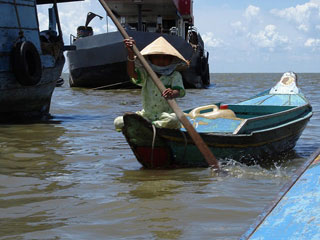 |
| Add caption |
-Phnom Dak Preah: located in Roleap village, Roleap commune, Pursat district, about 10 kilometers from the provincial town.
-Koh Sampeou Meas: located in front of the provincial hall in the middle of Pursat Island. It covers 2 hectares. Preah Theat: located in Sre Sdok village, Sre Sdok commune, Kan Deang district, about 20 kilometers from the provincial town.
This sites in Pursat province cater mostly to local people who visit them, especially on holidays or during the traditional festivals.Once past the mouth of the Tonle Sap, the floating village of Kompong Luong is found 30 kilometers into the lake, on its southwest shore. It's truly a floating village, with a large population of Vietnamese fishermen.Almost totally overlooked by tourists because of its remoteness and difficult access, the village is completely self-sufficient. A floating school, factories to make ice for fish preservation, church, pagoda, service stations, pigsty, stores, boat or television repair shops, video club, karaoke bar, police station... everything is on the water. All trades are represented and everybody from children to grandparents goes by boat through the network of canals that cross this little town.
O'Da Rapids
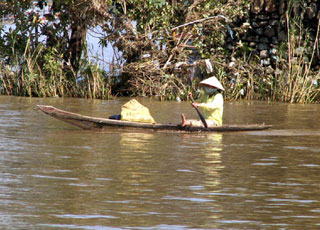 |
| Add caption |
O'Da Rapids is a river picnic area that the locals head out to on weekends to have a swim and kick back for a while about 52 km from town. There are Thais and Khmers working on building a logging road to extract timber from the area, which is why the river is now accessible for the locals on a fairly good gravel road for much of the way. The location is not really something to write home about, but the ride out gives you a chance to see life in the pursat countryside. To get there, turn left (if coming from Phnom Penh) at the small Caltex station (same as going to the hill temple). Down the road, 27 km from the turn, you come to the town of Leach, follow the curve of the right. At 0.7 km past that, turn left you will then see a mountain ahead. At 52.5 km past the Caltex turn, you arrive at a gate with entry fees listed, although there was nobody there to collect when I visited. The fees are listed in Khmer script, from 500 riel to 5,000 riel, depending upon whether you had a motorcycle; car of just came with others. Go beyond the gate to find the river and picnic areas.
Scenic Drive to Wat Bpahk-Dtrow A nice drive through rural farm country, followed by rolling forested hills, is what you get on the way to this hill temple area. With large boulders and trees lining the temple area, it's a favorite spot for the locals on Sundays and holidays. There are footpaths leading to the different temples and monuments throughout the area. There are food and drink stands near the parking area. To get there just head east from the river bridge on National Hwy5 (towards Phnom Penh) and turn right at the small Caltex gas station-you go under a brick and metal mesh gateway. Just follow this road for about twenty of twenty- five minutes (around 14 km) and you will see the hilltop temple in the distance on the left. Turn left at the blue white pillars.
Scenic Drive to Wat Bpahk-Dtrow A nice drive through rural farm country, followed by rolling forested hills, is what you get on the way to this hill temple area. With large boulders and trees lining the temple area, it's a favorite spot for the locals on Sundays and holidays. There are footpaths leading to the different temples and monuments throughout the area. There are food and drink stands near the parking area. To get there just head east from the river bridge on National Hwy5 (towards Phnom Penh) and turn right at the small Caltex gas station-you go under a brick and metal mesh gateway. Just follow this road for about twenty of twenty- five minutes (around 14 km) and you will see the hilltop temple in the distance on the left. Turn left at the blue white pillars.
Phnom Ba Klas
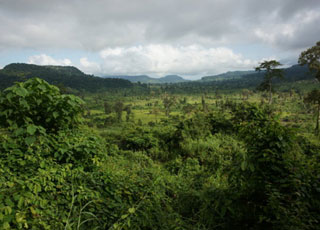 |
| Add caption |
Phnom Ba Klas is a natural and cultural site located in Tnaot Chum Village, Tnaot Chum cmmune, Krakor district, about 20 kilometers east of the provincial town. The site affords visitors beautiful scenery and abundant fresh air. The near by mountains are filled with a small fruit trees, especially Kuy and Sei moan, which are popular among visitors. An old, crumbling pagoda still contains many statues and sculptures. Khmer people still come there to worship.

